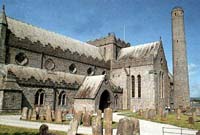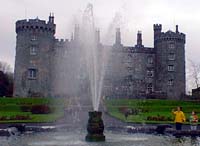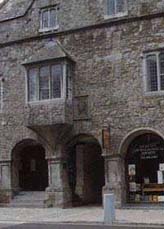Vacation Guide
Ireland golf vacation guide :
City and regional guide - Kilkenny
 The medieval city and county of Kilkenny offers an abundance of historic sites, castles and abbeys, forest parks, scenic locations, excellent craft shops, great pubs and tantalizing restaurants. Renowned as Ireland’s medieval capital, the city’s origins date back more than 1500 years. The building prowess of the Normans is very much still in evidence today, not alone in the shape of St. Canices Cathedral, the great Butler Castle and the four medieval abbeys, but also in the linear streets and attractive covered slipways. The place is simply buzzing with atmosphere and with series of festivals such as the Kilkenny Arts Festival and the Murphy’s Cat Laughs Festival, it is hard to beat as a holiday destination.
The medieval city and county of Kilkenny offers an abundance of historic sites, castles and abbeys, forest parks, scenic locations, excellent craft shops, great pubs and tantalizing restaurants. Renowned as Ireland’s medieval capital, the city’s origins date back more than 1500 years. The building prowess of the Normans is very much still in evidence today, not alone in the shape of St. Canices Cathedral, the great Butler Castle and the four medieval abbeys, but also in the linear streets and attractive covered slipways. The place is simply buzzing with atmosphere and with series of festivals such as the Kilkenny Arts Festival and the Murphy’s Cat Laughs Festival, it is hard to beat as a holiday destination.
The first city charter was granted to Kilkenny by James I as a result of the actions of Black Tom, the 10th Earl of Ormonde, who was a trusted friend of Queen Elizabeth. In 1609, a royal charter constituting Kilkenny as a city rewarded his support of the crown. Following the Ulster rebellion of 1641, a Confederacy was set up to unite Catholics in defence of their common faith, rights and liberties and Kilkenny was selected as the national parliament. Buildings such as Rothe House and Kilkenny Castle served as useful meeting places for the parliament, supreme council and the bishops and clergy. The Confederation sat for six years until 1648 and governed the country during a period of extreme turmoil. James II granted the second city charter in 1687 and Kilkenny will celebrate its 400th anniversary as a city in 2009.
 The city of Kilkenny, as well as being an extremely interesting place to walk around and explore, offers a wide range of attractions to visitors. Probably the best known of course is Kilkenny Castle, which has been an important site since Strongbow constructed the first building (a wooden tower) there in the 12th century. The first stone castle, a square shaped structure with towers at each corner, was constructed in 1260 and three of these four towers survive to this day. The Butler family bought the castle in 1391 and lived there continuously until 1935. The property was given to the Nation in 1967 and is now managed by the National Heritage Council. The castle is open for guided tours, while the splendid gardens are open to the public.
The city of Kilkenny, as well as being an extremely interesting place to walk around and explore, offers a wide range of attractions to visitors. Probably the best known of course is Kilkenny Castle, which has been an important site since Strongbow constructed the first building (a wooden tower) there in the 12th century. The first stone castle, a square shaped structure with towers at each corner, was constructed in 1260 and three of these four towers survive to this day. The Butler family bought the castle in 1391 and lived there continuously until 1935. The property was given to the Nation in 1967 and is now managed by the National Heritage Council. The castle is open for guided tours, while the splendid gardens are open to the public.
St. Canices Cathedral, Ireland’s second largest medieval cathedral, is one of Kilkenny’s most famous landmarks. Established as a monastic settlement by St. Canice in the 6th century, the cathedral itself was built in the early 13th century. Following near destruction by Oliver Cromwell’s troops in 1650, it was restored in the 18th century and today serves as a powerful reminder of Kilkenny’s past. Founded by William Marshall the Younger for the Dominican Friars in 1225, the Black Abbey is also worth a visit. At the centre of civic life in Kilkenny for centuries, it was repressed in 1543 and served as a courthouse until the end of the 17th century. Restored in 1778, the Abbey did not become a place of public worship until the mid 19th century and today its antique stained-glass windows and fascinating statues are among the main attractions.
 Another structure that played a significant role in local history is Rothe House, a magnificent Tudor mansion built at the height of the Italian Renaissance by a wealthy merchant called John Rothe. During the Confederation of Kilkenny, many dignitaries were entertained here by John Rothe and his cousin, the Bishop of Ossory. Today the building has been wonderfully restored and is home to the Kilkenny Archaeological Society and the National Headquarters of the Heritage Council.
Another structure that played a significant role in local history is Rothe House, a magnificent Tudor mansion built at the height of the Italian Renaissance by a wealthy merchant called John Rothe. During the Confederation of Kilkenny, many dignitaries were entertained here by John Rothe and his cousin, the Bishop of Ossory. Today the building has been wonderfully restored and is home to the Kilkenny Archaeological Society and the National Headquarters of the Heritage Council.
Outside the city of Kilkenny, there are many picturesque towns and villages, which should be visited if possible. These include Graiguenamanagh, home to Duisk Abbey, a fully restored early Cistercian church; Callan, the birthplace of Edmund Rice, founder of the Christian Brothers; and lovely Inistiogue, where the movie "Widows Peak", starring Mia Farrow was filmed. Thomastown is another place worthy of mention. Besides being home to Mount Juliet Golf Club, the famous Jerpoint Abbey is also located here. Founded in the latter half of the 12th century, Jerpoint is an outstanding Cistercian Abbey, which flourished until the 16th century when it passed to the Earl of Ormonde. Among the highlights of the Abbey are the exquisite carvings on the 16th century tombs, the sculptured cloister arcade and the beautiful Romanesque architecture.
Choose another destination
• Aran Islands •Belfast •Connemara •Cork •Dublin •Galway •Kilkenny
•Killarney •Waterford •Wexford •Wicklow



